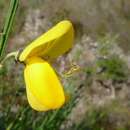en
names in breadcrumbs


Cytisus scoparius (Broom; syn. Sarothamnus scoparius) is a species in the pea family Fabaceae. It is native to much of Europe, from the British Isles east to southern Scandinavia, south to Iberia, and east to Belarus and Romania. Further northeast, its range is limited by its lack of tolerance of severe winter cold, with temperatures below around -25° to -30°C killing the stems. It is a woody shrub with green photosynthetic shoots, and small caducous leaves present only in spring and early summer. The leaves are simple or trifoliate, 5-15 mm long. Young shoots remain green for several years, silky-hairy at first, and have up to five small longitudinal ridges. Older stems have finely flaky to stringy grey-brown bark. The flowers are bright yellow, 1-2 cm long in bud opening to 2-3 cm long, with the typical pea flower structure; they are produced in mid spring to early summer and are pollinated by bees. The seeds are 3-4 mm diameter, produced in a 2-5 cm long pod, green ripening black. Seed dispersal starts with explosive pod splitting in hot sunny weather, and is continued further by ants, which feed on the small fleshy peduncle at the base of the seed. The seeds are long-persistent in the soil (up to 20-30 years); this can enable the species to survive periodic bush fires, and also to survive in colder regions of northeastern Europe (southern Scandinavia, Poland, etc.) where periodical severe winters may kill the entire adult population.
There are two subspecies, which differ mainly in growth habit:
* Cytisus scoparius subsp. scoparius (Common Broom). An erect shrub, growing to 2-3 metres (rarely 4 m) tall; shoots thinly hairy at first, soon becoming glabrous. This is the common form, occuring throught most of the species range.
* Cytisus scoparius subsp. maritimus (Rouy) Heywood (Prostrate Broom). A prostrate, ground-hugging shrub, not exceeding half a metre in height; shoots densely silky-hairy. It is restricted to the Atlantic coasts of southern Ireland, west Wales, southwestern England, and northwestern France.
Broom (primarily subsp. scoparius) is widely cultivated as a garden plant, and for wildlife benefit. The Andreanus Group cultivars are particularly popular, selected for their bright orange-red to pink flowers. It is also naturalised, and sometimes an invasive weed species, in parts of Australia, New Zealand, India, and North America.
The English name derives from its historical use in the manufacture of brooms, as the harvested twigs retain a degree of flexibility in use without becoming brittle. A number of other English names, some of them offensive, have been applied to the species outside of its native range.